This post may contain affiliate links. Please read our disclosure policy.
Make the best soft fluffy whole wheat Chinese steamed buns (wholemeal) with this easy foolproof recipe using tangzhong. All the tips you need to get smooth steamed buns in 3 different ways: fold-over steamed buns, mantou, and round steamed buns.

My family loves it when I made my soft fluffy Chinese steamed buns. I really love that recipe too as it produces soft fluffy and very smooth steamed buns. I was never a fan of whole wheat flour (or known as wholemeal flour) as a kid, but now as an adult, especially for the past 5 years I’ve started making my own bread with whole wheat flour, I’ve really came to love whole wheat flour. I personally think whole wheat flour has that sweet nutty aroma that I really like. It tastes much better too. I know many people may not agree with this part. Thankfully, my two kiddos don’t really care whether I serve them whole wheat steamed buns or regular white steamed buns. They are accustomed to both!
WHY YOU WILL LIKE THIS WHOLE WHEAT STEAMED BUNS RECIPE
1. YOU CAN DO 100% WHOLE WHEAT STEAMED BUNS
Many whole wheat steamed buns recipes out there use a combination of all-purpose flour or Hongkong bao flour with whole wheat/wholemeal flour. This combination is to ensure that the whole wheat steamed buns won’t be too dense. Tell you what people, I managed to do 100% whole wheat steamed buns that are still soft and fluffy and really good too.
2. YOU CAN ALSO CHOOSE TO DO 50% WHOLE WHEAT STEAMED BUNS
I experimented by using 50% whole wheat flour and 50% cake flour. The result is a much lighter bun compared to 100% whole wheat steamed buns, BUT, when the family tasted both, they really think the 100% whole wheat steamed buns are very comparable in terms of softness and fluffiness compared to 50% whole wheat.
3. YOU CAN ALSO CHOOSE TO USE TANGZHONG
Why tangzhong? You can read about its detail in this How to prepare tangzhong.
Tangzhong makes the baozi stays soft for days and that’s why I love using tangzhong in bread and steamed buns recipes.

INGREDIENTS
1. WHOLE WHEAT FLOUR / WHOLEMEAL FLOUR
I used King Arthur whole wheat flour, which has about 14% gluten content. You can use whichever brand you like.
2. CAKE FLOUR OR ALL-PURPOSE FLOUR
If you are going to do 50-50 combination, you can use cake flour or a combination of all-purpose flour and cornstarch to make the cake flour. If you must substitute, you can use all-purpose flour but the texture of the baozi just won’t be as soft
3. YEAST
You can use either instant or active-dry yeast
4. SUGAR
I use regular white sugar and the amount is really small. If you want to make it sweeter, you can increase the amount of sugar to your taste
5. COOKING OIL
Use any neutral-tasting cooking oil. I usually use grapeseeds oil. I’ve seen some recipe uses shortening. It’s up to you.
6. MILK OR WATER
I prefer to make steamed buns with milk, but you can absolutely use water to make it vegan-friendly. Make sure to start with cold milk or water or at least room temperature.
7. SALT
Just a small amount of salt is needed to enhance the overall taste of the steamed buns.
The recipe is updated on May 14, 2023 to include how to prepare whole wheat steamed buns using tangzhong.
Soft Fluffy Whole Wheat / Wholemeal Steamed Buns (Mantou / Bao)
Ingredients
For 100% whole wheat steamed buns:
- 300 g whole wheat flour or wholemeal flour
- 4 g instant yeast
- 30 g sugar
- ¼ tsp salt
- 20 g cooking oil
- 200 g milk or more as needed
For 50-50 whole wheat steamed buns:
- 150 g cake flour see notes
- 150 g whole wheat flour
- 4 g instant yeast
- 30 g sugar
- ¼ tsp salt
- 20 g cooking oil
- 245 g milk or more as needed
For tangzhong:
- 25 g cake flour see notes
- 125 g milk
For the dough:
- 125 g cake flour see notes
- 150 g whole wheat flour
- 4 g instant yeast
- 30 g sugar
- 20 g oil
- ¼ tsp salt
- 75 g milk or more as needed
If using tangzhong for 100% whole wheat steamed buns:
For tangzhong:
- 25 g whole wheat flour
- 150 g milk
For the dough:
- 275 g whole wheat flour
- 4 g instant yeast
- 30 g sugar
- ¼ tsp salt
- 20 g oil
- 95 g milk or more as needed
Instructions
If using tangzhong:
- Combine the first two ingredients under tangzhong, in a non-stick pan or a saucepan. Use a whisk to stir to combine until you don't see any more lumps.
- If you are preparing whole wheat tangzhong for 100% whole wheat bao, let the whole wheat flour soaks in the milk/water for 15 minutes as whole wheat flour needs time to hydrate.
- Put on the stove and turn the heat to low-medium and keep stirring
- The mixture will start to thicken. Remember to keep stirring and don't crank up the heat. If you use an instant-thermometer to measure, it should be about 65 C/149 F (a bit over is not a big deal). The mixture thickens but we don't want to overcook it and the liquid evaporates too much. Which is why using a thermometer helps a lot
Make the dough with a machine:
- Mix flour, yeast, salt, sugar, tangzhong (if using) and oil in a mixing bowl. If you use a machine, use a dough hook attachment. Turn on the mixer, start on speed 2 (on Kitchen Aid) and gradually add the liquid (it's important to start with room temperature or cold liquid), start with the lowest amount of liquid and then add as necessary until a dough is formed. Don't dump all the liquid all at once. Knead for about 5 minutes on speed 2 until you get a rough dough. Cover and let the dough rest for 15 minutes. This allows the wheat flour to be hydrated, especially if you are preparing 100% whole wheat bao.
- After 15 minutes, turn the machine back on and continue to knead on speed 2 for 5 minutes. Feel the dough. It should feel soft. If it feels stiff, add more milk, 1 teaspoon at a time. Whole wheat flour is a very "thirsty" flour and needs more hydration. Continue to knead until the liquid is absorbed.
- There is no need to reach a windowpane. Just knead until the dough is soft and smooth. Every brand of whole wheat flour is different, so it is important that you feel the dough and add liquid accordingly. This is the key to get soft whole wheat steamed buns, soft dough that is just slightly sticky to the touch.
Make the dough by hands:
- If you are kneading by hands, mix until you get a rough dough (it's not going to be smooth yet). Cover and rest it for 15 minutes. Then go back and knead it. You'll be surprised by how easier it is to knead it now. Knead until the dough is smooth and pliable, about 15-20 minutes. At any point during kneading, you can always stop and rest the dough if you find it hard to knead. This is to relax the gluten. Then go back to knead again and you'll be surprised by the difference it makes by just resting the dough before kneading again. It's easier for you too
Rest the dough:
- Cover and rest the dough for 15 minutes. This is not to proof the dough. It shouldn't double in size. This is to relax the gluten for easier shaping and rolling the dough
If doing fold-over steamed buns:
- Instead of dusting your work surface with flour, spray some cooking spray or use a bit of oil. The more flour you add to the dough, the drier and tougher it gets. Divide the dough into 8-10 equal portions (depending on the size you want). Keeping the dough covered and work with one dough at a time
- Roll into a round ball. Flatten with your palm and then use a rolling pin to roll it into an oval shape. Fold the dough over and place on a parchment paper. Repeat with the rest and proceed to proofing step
If doing round steamed buns:
- Instead of dusting your work surface with flour, spray some cooking spray or use a bit of oil. The more flour you add to the dough, the drier and tougher it gets. Divide the dough into 8-10 equal portions. Keeping the dough covered and work with one dough at a time
- Pull and tuck the dough from top to bottom so the seams are at the bottom and the surface is relatively smooth
- Roll the dough into a smooth round ball in between the palm of your hand REALLY make sure the dough is smooth.
- Cup the dough with both palms and move the dough in a circular motion to shape it taller. This part is important so your steamed buns come out tall instead of spreading to the side after steaming
- Place on a piece of parchment paper. Proceed to the proofing step below
If doing mantou shape:
- Instead of dusting your work surface with flour, spray some cooking spray or use a bit of oil. The more flour you add to the dough, the drier and tougher it gets
- Roll the dough out into rectangle, about 9 x 12 inch then roll it up like a Swiss roll. Use a sharp serrated knife to cut into 8-10 pieces. The two end pieces may be a bit smaller compared to others. Place on parchment paper and proceed to the proofing step below
Proofing the steamed buns:
- Keep the shaped steamed buns covered with a towel and let them proof until about 50% bigger than the original size, it may take about 30 minutes to 1 hour, maybe a bit longer if it's winter. Don't go by the time. It should feel lighter and slightly puffy after proofing. The dough should feel lighter when you lift it up. Do a finger-poking test be by gently push the dough with your floured finger. The dough should bounce back slowly and leave some indentation. The buns are done proofing. If it bounces back almost immediately, proof a bit longer and check again.
Steaming:
- Most likely your steamer won't be able to accommodate steaming all buns at one go. You may need to steam in 2-3 batches, which means, the rest of the batches will sit longer and continue to proof while waiting for the steamer. If you think the buns are proofing way too fast (getting bigger too fast), here's what you can do: Make sure to cover them with plastic wrap and then place them in the refrigerator to slow down the yeast activity or halt it all together until they are ready to be steamed
- Bring the water in your steamer to a boil. Wrap the lid of your steamer with a kitchen towel to prevent moisture dripping back on the steamed buns as this will create "burn" spots
- LOWER THE HEAT TO MEDIUM. Place the buns in there, leaving about 1-inch space in between. Close the lid and leave about 1/4-inch gap to let some steam escape and steam like this for 8 minutes. Steaming them this way will give you a very smooth surface without any wrinkle
- After steaming, turn off the heat. DO NOT OPEN THE LID of the steamer. Let the buns sit there for 1 minute like this. The buns will not sink or wrinkle due to the sudden change in temperature
COOLING:
- Remove the buns to a wire rack to let them cool down. This is to ensure the bottom of the steamed buns will not be wet and soggy
STORING:
- If you make extra and plan to store them, let the already steamed buns cooled down completely and then place them on a baking sheet, not touching each other, and then put the entire tray inside the freezer for about 1 hour. They will harden, but not completely frozen yet. Transfer to a freezer bag and they will not stick to each other anymore. Try not to keep for more than 1 month
REHEATING:
- They can go straight from freezer to steamer when you ready to eat them. Steam on high heat for 5 minutes and they are as good as new
Marv’s Recipe Notes
*Nutrition facts are just estimates and calculated using online tools*
HOW TO MAKE SOFT AND FLUFFY WHOLE WHEAT CHINESE STEAMED BUNS
1. PREPARE TANGZHONG
Combine the first two ingredients under tangzhong, in a non-stick pan or a saucepan. Use a whisk to stir to combine until you don’t see any more lumps. If you are preparing whole wheat tangzhong for 100% whole wheat bao, let the whole wheat flour soaks in the milk/water for 15 minutes as whole wheat flour needs time to hydrate. 
Put on the stove and turn the heat to low-medium and keep stirring. The mixture will start to thicken. Remember to keep stirring and don’t crank up the heat. If you use an instant-thermometer to measure, it should be about 65 C/149 F (a bit over is not a big deal). The mixture thickens but we don’t want to overcook it and the liquid evaporates too much. This is why using a thermometer helps a lot
Cover with a cling wrap, touching the surface of the tangzhong to prevent a skin from forming. Let it cool down completely before using. You can use it on the same day once it has cooled down. If you have the time, once the tangzhong has cooled down, store it in the fridge for at least 8 hours or for 2-3 days. This greatly improves the taste of your finished product. When ready to use, you don’t need to let it come to a room temperature and it can be used in the recipe right away. I don’t find any difference whether I let it comes to room temperature or not before I use it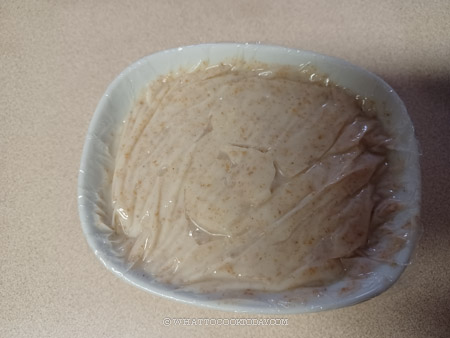
2. MAKE THE DOUGH
Mix flour, yeast, salt, sugar, tangzhong (if using) and oil in a mixing bowl.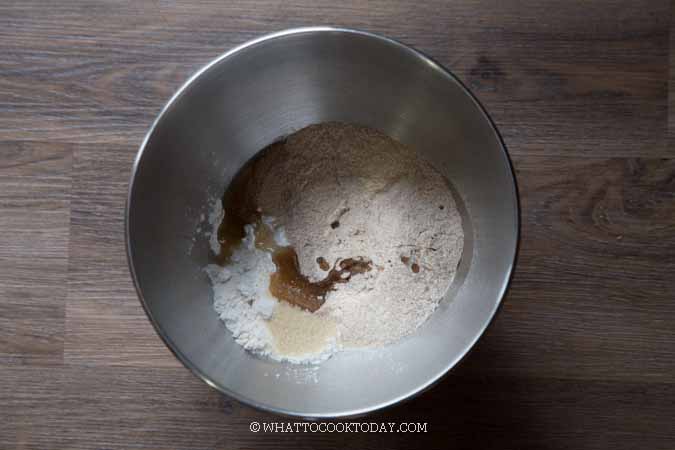
If you use a machine, use a dough hook attachment. Turn on the mixer, start on speed 2 (on Kitchen Aid) and gradually add the liquid (it’s important to start with room temperature or cold liquid), start with the lowest amount of liquid and then add as necessary until a dough is formed. Don’t dump all the liquid all at once. Knead for about 5 minutes on speed 2 until you get a rough dough. Cover and let the dough rest for 15 minutes. This allows the wheat flour to be hydrated, especially if you are preparing 100% whole wheat bao.
After 15 minutes, turn the machine back on and continue to knead on speed 2 for 5 minutes. Feel the dough. It should feel soft. If it feels stiff, add more milk, 1 teaspoon at a time. Whole wheat flour is a very “thirsty” flour and needs more hydration. Continue to knead until the liquid is absorbed.
There is no need to reach a windowpane. Just knead until the dough is soft and smooth. Every brand of whole wheat flour is different, so it is important that you feel the dough and add liquid accordingly. This is the key to get soft whole wheat steamed buns, soft dough that is just slightly sticky to the touch.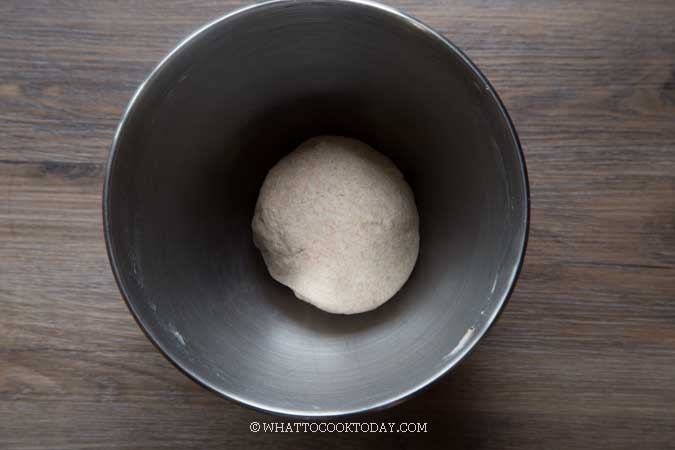
2. SHAPING
For fold-over steamed buns: Divide the dough into 8 equal portions. Keep them covered and work with one dough at a time. Roll into a round ball. Flatten with your palm. Use a rolling pin to roll it into an oval shape. You can place a piece of parchment paper (or you can skip this part and brush with some oil) and fold the dough over and place it on another parchment paper.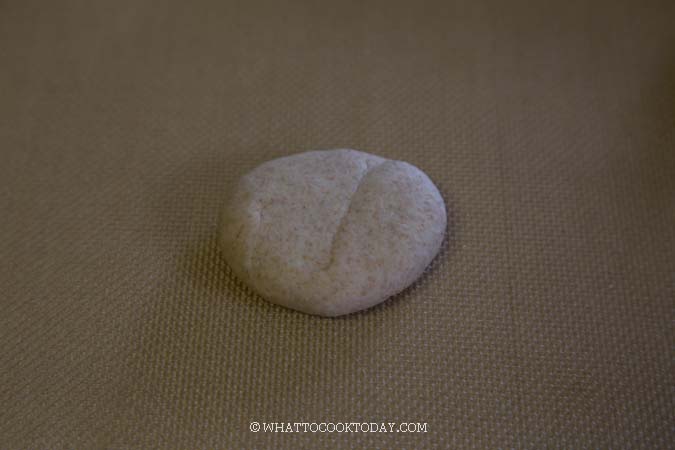

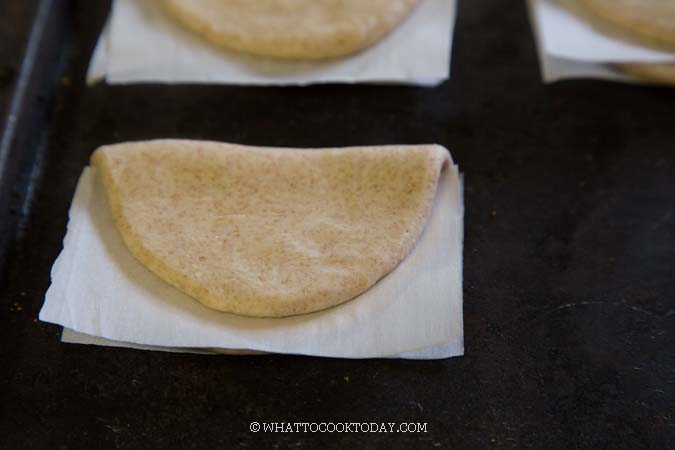
For round steamed buns: Divide the dough into 8 equal portions. Keeping the dough covered and work with one dough at a time. Pull and tuck the dough from top to bottom so the seams are at the bottom and the surface is relatively smooth. Roll the dough into a smooth round ball in between the palm of your hand REALLY make sure the dough is smooth. Cup the dough with both palms and move the dough in a circular motion to shape it taller.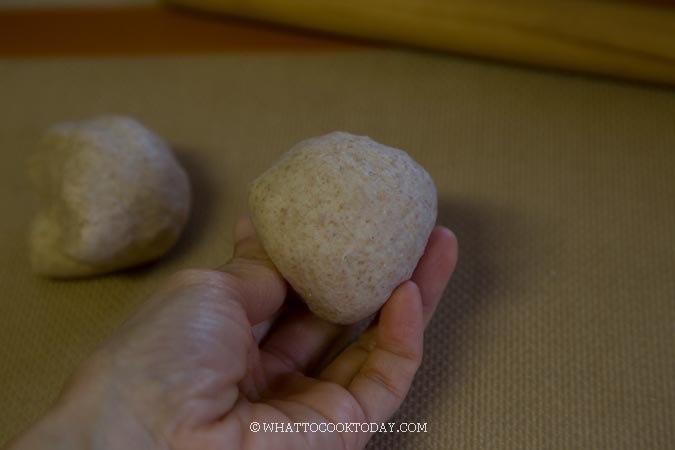
For mantou shape: Roll the dough into a long log. (I used a slightly different method in the video, either way works)
Use a dough cutter (serrated knife) to cut into 8 equal portions. Look at how the dough is squished when I used a dough cutter. In the video, I used a serrated knife and the mantou shape was nice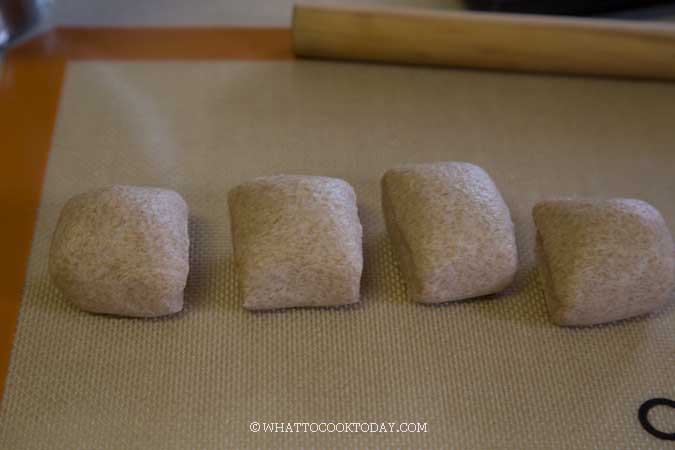
3. PROOFING
Keep the shaped steamed buns covered with a towel and let them proof until about 50% bigger than the original size, it may take about 30 minutes to 1 hour, maybe a bit longer if it’s winter. Don’t go by the time, go by how the steamed buns look like. It should feel lighter and slightly puffy after proofing
4. STEAMING
Bring the water in your steamer to a boil. Wrap the lid of your steamer with a kitchen towel. LOWER THE HEAT TO MEDIUM. Place the buns in there, leaving about 1-inch space in between. Close the lid but leave about 1/4-inch gap to let some steam escape during steaming. 
After steaming do not rush to open the lid. Let them sit in there for 5 minutes and then transfer to the cooling rack. This helps to prevent the bottom from getting soggy.
100 % WHOLE WHEAT STEAMED BUNS AND 50-50 WHOLE WHEAT STEAMED BUNS COMPARISON
Can you tell which one of these are made with 100% whole wheat flour? :)It’s not easy to spot unless you look closely at the color. Hint: The 100% whole wheat flour has a deeper brown color!

This was made with 50-50 whole wheat flour and cake flour. The color is lighter.
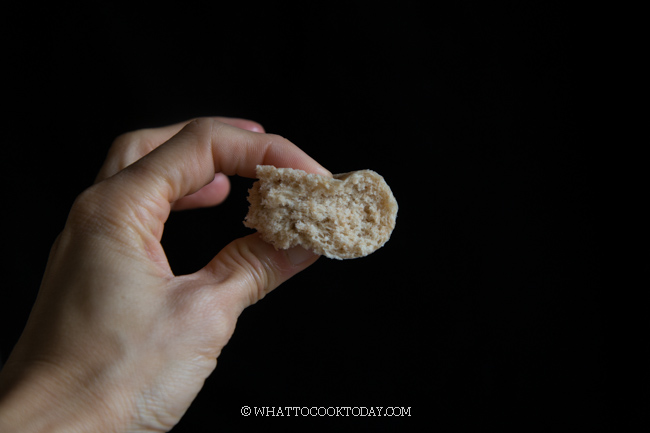
This was made with 100% whole wheat flour.
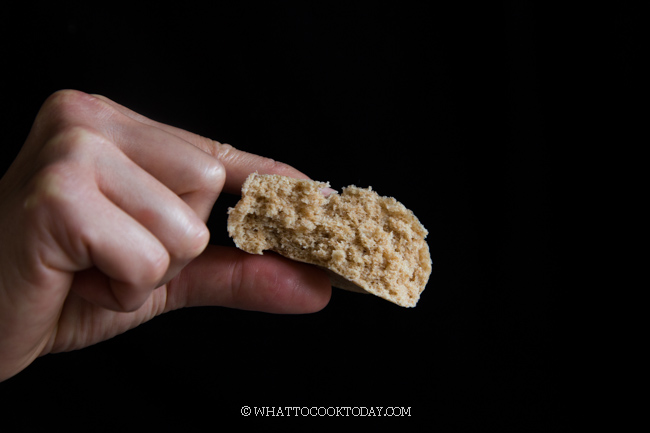
VERDICT: In terms of fluffiness, the 50/50 whole wheat steamed buns are lighter and fluffier. The 100% whole wheat bao feels a bit denser, which is expected. This is applicable to both whether using tangzhong or not. The only difference with bao using tangzhong is, they stay soft for few extra days compared to the one made without tangzhong. The ones made without tangzhong won’t be as soft after they have cooled down completely, which is normal, but will be very soft again once reheated.

My mom was pretty stoked that the 100% whole wheat steamed buns came out soft and fluffy, which means, she would start making 100% whole wheat steamed buns too 🙂 I’m very happy with the result too.
THE RECIPE REALLY GIVES SMOOTH STEAMED BUNS
Even though the whole wheat steamed buns will not be as silky smooth as baby bottom compared to the regular white steamed buns because of the whole grains, but you can expect really smooth steamed buns without any wrinkles or bumpy top with this recipe.

VARIATIONS
1. Filling
This is basic whole wheat bao without any filling, but you can use any savory or sweet filling
2. Add seeds and dried fruit
You can make it even heartier by adding seeds like pumpkin seeds, flax seeds, etc or dried fruit like raisins or cranberries when you mix all the dry ingredients. You may need a bit more liquid to form the dough
3. Make it vegan and dairy-free
Replace milk with non-dairy milk or water

CHECK OUT THIS SOFT AND FLUFFY STEAMED BUNS MADE WITH REGULAR WHEAT FLOUR
I wrote pretty detailed explanations on how to get smooth fluffy steamed buns in this soft fluffy Chinese steamed buns post, so you are welcome to check it out if you are interested. The same concept is applicable to whole wheat steamed buns too.
These Soft and Fluffy No-Yeast Chinese Steamed Buns are so good and super easy to make!
DID YOU MAKE THIS SOFT AND FLUFFY CHINESE WHOLE WHEAT STEAMED BUNS RECIPE?
I love it when you guys snap a photo and tag to show me what you’ve made 🙂 Simply tag me @WhatToCookToday #WhatToCookToday on Instagram and I’ll be sure to stop by and take a peek for real!

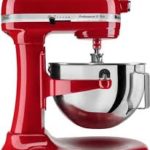



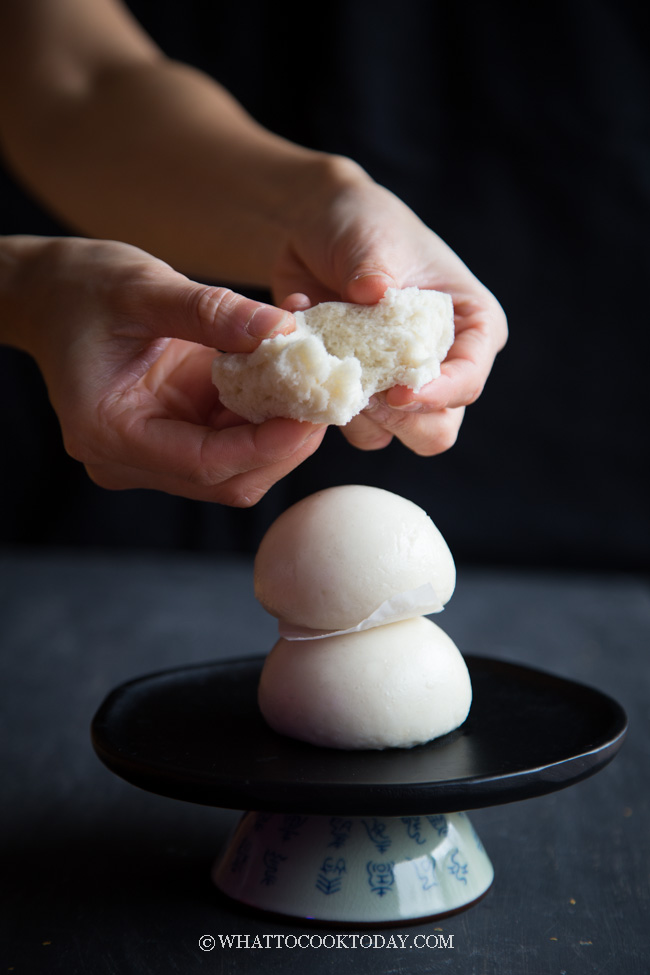
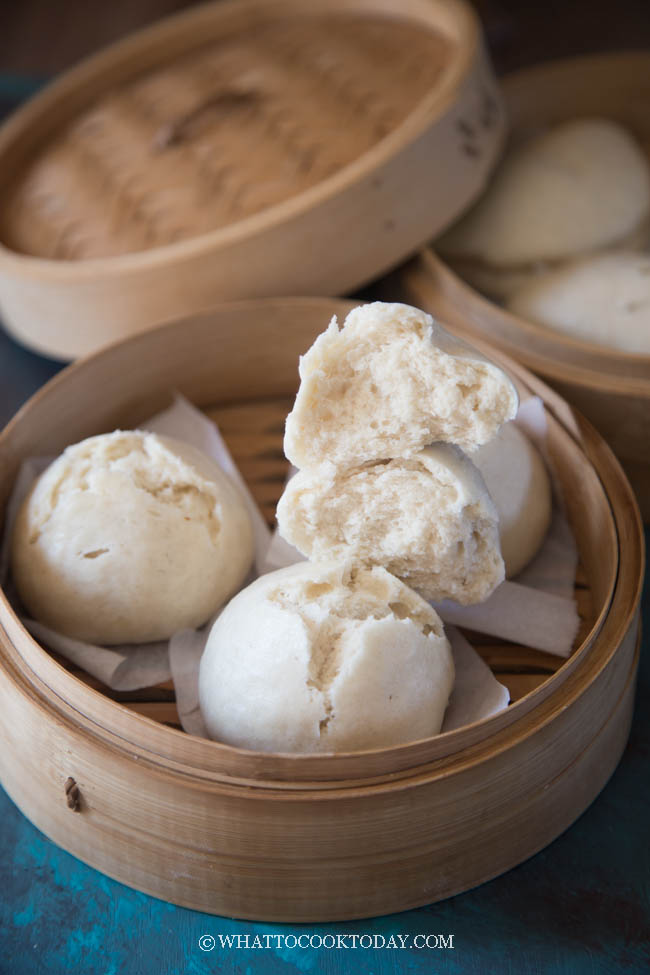

40 comments
Hi Marv, greetings from Jakarta. I found your site through pinterest and I love it. You wrote detailed instructions and even gave notes for any problems might incur. I’m feeling happy now because you have whole wheat steamed buns! I will make them and tag you on IG. Thank you
Hi Novi, I’m glad you find them useful 🙂 I can’t wait to see the whole wheat steamed buns, I’ll be sure to check it out on IG then 😉
Hi… We are a vegan couple and we tried your Steamed Whole wheat Mantou recipe for dinner today. Kneaded it by hand too. It came out real well… We loved it…. We just toasted the buns on a pan, just for a crisp… We were longing for such an easy vegan bread recipe for so long. Thank you… Love from India… Sandhya and Sanjeev
Hello Sandhya and Sanjeev, I’m so happy to know that you enjoy the whole wheat steamed buns. It’s such a great idea to toast it on a pan too. This buns can be cooked on the pan too if no steamer available. Thank you for your feedbacks! 🙂
I made these today with soy milk and 50/50 wholemeal spelt/ self raising flour (no cornstarch in for the cake flour suggested) and they came out so lovely and fluffy
They are a little different than the usual white bao but delicious. Going to try 100% spelt next so I can enjoy them more often 😋 I was feeling a little lazy so added salt with the other dry ingredients and skipped the autolyse and seemed to work just fine so if you wanna make them even quicker it’s doable
Hi Rebecca, I’m glad the combination worked out for you. I want to try spelt flour too next time. Thank you for sharing what you did 🙂
Hi, if I want to make the round buns with filling inside, with pork for example, do I have to do something different?
Hi Cleo, no you don’t 🙂 The recipe works with just plain or if you want to fill it with any sweet or savory fillings. Hope it makes sense.
If i don’t use a machine, how long i should knead the dough? Thank you
If you knead by hands, knead until the dough comes into a mass. It may be still a rough dough. Cover and let it rest for 15 minutes and then come back and knead it again you will find it so much easier to knead now as the gluten has relaxed. Knead it into a smooth non-sticky dough, about 8-10 minutes. I hope this helps. I have updated the recipe accordingly!
Hi,
Thanks for this great simple recipe!
Would it be okay to substitute vegetable oil with coconut oil?
And I also thought of adding ingredients like ground flaxseed and chia seeds to make the buns healthier. Just a little bit. Do you think it will be okay?
Hi Jaymee,
Absolutely, you can use coconut oil and also adds some seeds to it. That will be totally okay!